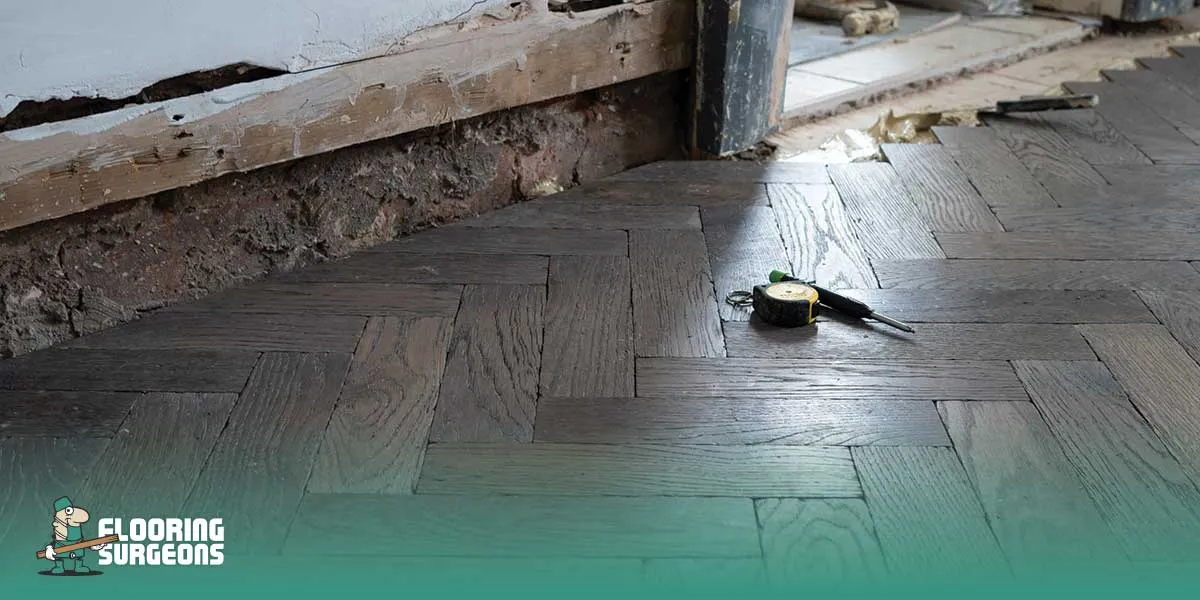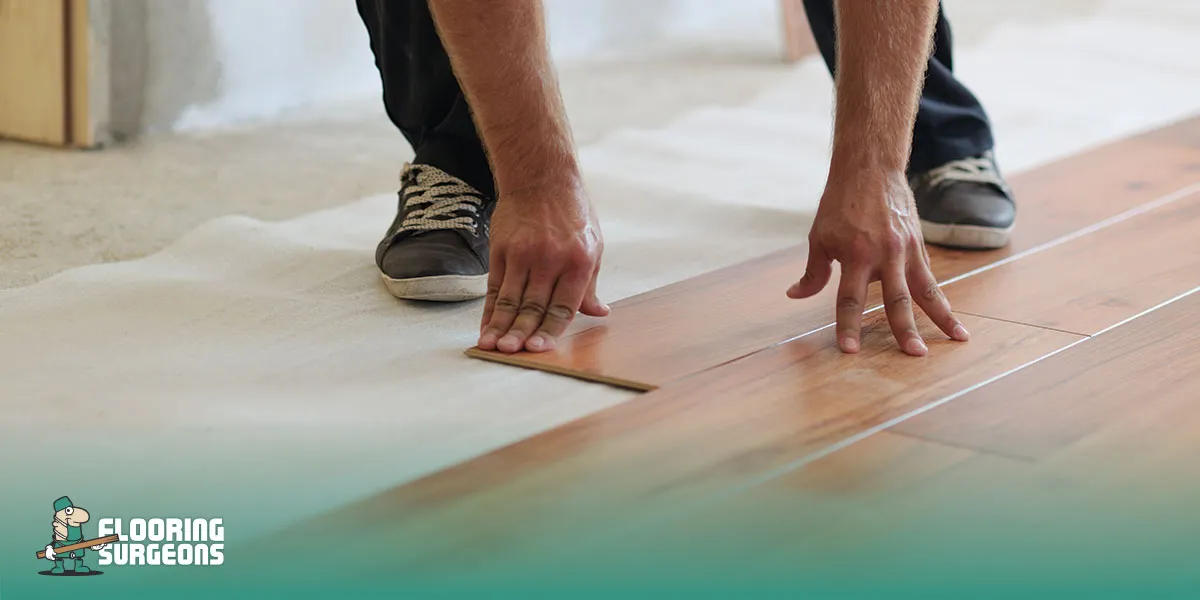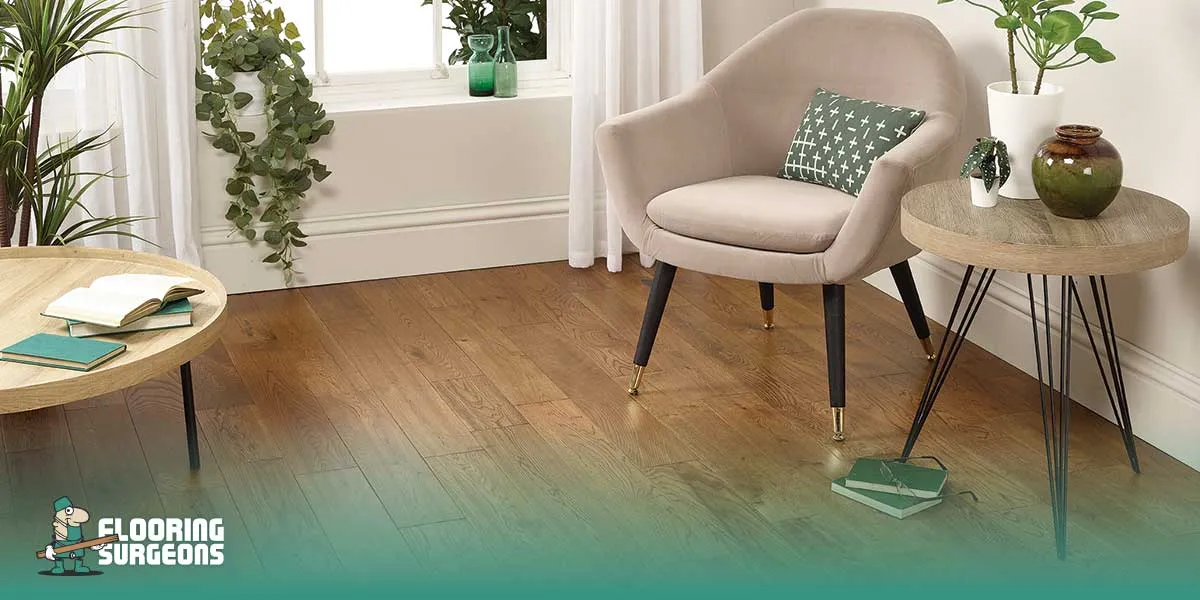Solid wood is one of the most popular flooring choices. It brings depth, warmth, and a sense of connection to nature to interior decor, and it has been a favorite for generations. Whether you’re looking to enhance your living room or transform your hallway, solid wood flooring can elevate your interior decor. If this is your type, too, and you want to know more about how to install solid wood flooring, we prepared a full guide for you to learn everything from zero to a hundred.
If you’re ready to dive into the process of installing solid wood flooring, it’s important to understand the steps involved, and the preparation required for a successful installation. Whether you’re choosing to install a solid hardwood floor yourself or hiring a professional, knowing the basics will ensure that your new floor lasts for years.
In this guide, we’ll cover everything you need to know, from the materials required to the techniques used for proper installation. We will also discuss the cost to install solid wood flooring and what factors contribute to the solid wood flooring installation cost, helping you make informed decisions when planning your project. By the end, you’ll have all the knowledge you need to achieve a flawless, high-quality hardwood floor in your home.
Preparing for Installation
Before solid wood installation, ensure that both the space and the solid wood floorboards are properly prepared. Proper acclimation of the wood is crucial, so let the floorboards sit in the room for 48 hours.
When considering how to install solid wood flooring, the surface type will determine the steps. If you’re working with concrete, make sure the surface is clean, dry, and level. You may need a vapor barrier before glueing or nailing down the wood.
For installation over a wood subfloor, ensure the subfloor is sound, clean, and dry. Nailing the boards into place is the most common method for wood subfloors, ensuring a strong and secure fit.
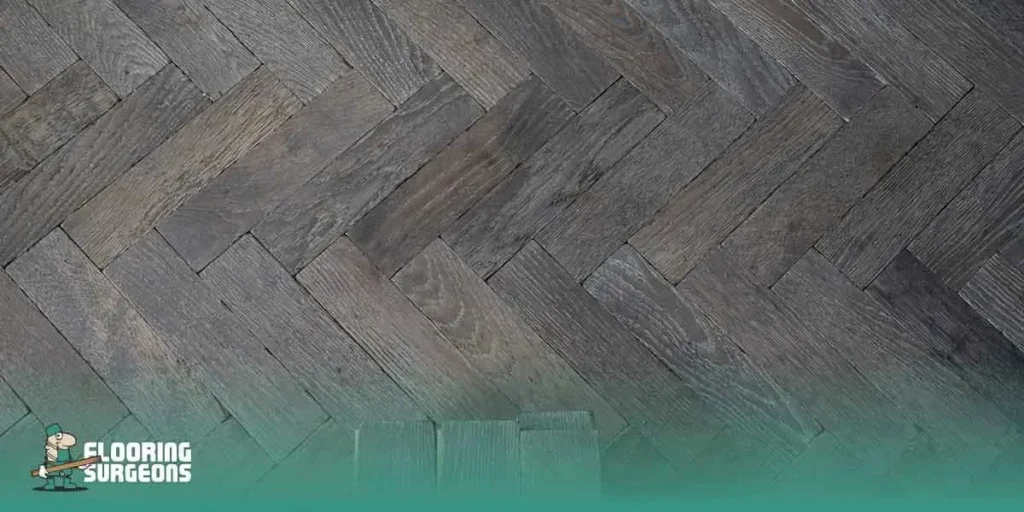
Measuring and Ordering the Correct Amount
Measure the room size in square meters (length x width = m²) to determine how much flooring you need, then add 10-15% extra for cutting and wastage.
Ensure the room width is divided by the width of a panel, accounting for expansion gaps. If the last row is under 60 mm, trim the first board along its length for a seamless finish.
Read more: How to measure a room for flooring.
Before moving on to subfloor preparation, it’s essential to understand the importance of a solid foundation for your solid wood flooring. A well-prepared subfloor ensures stability and prevents issues such as squeaking or uneven flooring. Proper preparation will make the installation process smoother and help extend the lifespan of your floor.
Subfloor Preparation
After determining how much flooring is needed, start cleaning any debris or dust from the subfloor. Check any nails or screws and make sure they are not protruding and are completely secured. And old adhesives must be removed.
Use a long, straight edge and spirit level to check the subfloor’s level, ensuring it doesn’t vary by more than 3 mm over 1 meter. If you notice uneven spots, try to fix them by using a self-levelling compound or proper underlayment to ensure they are smooth and solid wood can be installed properly.
Inspecting Your Solid Wood Floor
Upon receiving the flooring, it’s important to check a few pieces. As natural wood can vary significantly between batches, it’s essential to inspect the grading, finish, and quality to ensure the product meets your expectations.
Once you’ve inspected your solid wood flooring to ensure it meets your expectations, the next step is to let the wood adjust to its new environment. Acclimating the wood is crucial for preventing issues like expansion or contraction once installed.
Acclimating the Wood
Now it’s time for the solid wood to get to know their new space! Therefore, you should leave unopened packs flat for at least 7 days. Stack them with spacers between the packs for airflow. Avoid leaning the packs against a wall or stacking them more than three high. Normal living conditions must be maintained; the room should have a humidity level between 45% and 65%. If the room is usually heated, keep the heating on as normal.
Expansion Gaps and Spacing
For solid wood flooring, it’s essential to leave an expansion gap around the perimeter of the room. Leave a 10-12 mm expansion gap around the room’s perimeter, including walls, skirting boards, pipes, and doorframes. Limit the installation width to 5m and the length to 7m across the grain. In larger rooms, use expansion bars or spacers to manage wood expansion and maintain a professional finish.
Essential Tools for Installing Solid Wood Flooring
Here’s a list of essentials and suggestions to ensure the job runs smoothly.
Having the right tools is essential for installing solid wood flooring. From cutting the planks to securing them in place, using the right equipment makes the installation process much easier and helps you achieve a professional finish.
Essential Items for solid wood installations
- Hand Saw / Electric Chop Saw: These tools will help you cut the wood planks to the desired length with ease. A chop saw is especially useful for quick and accurate cuts.
- Pencil: A simple but essential tool for marking measurements and cut lines accurately.
- Measuring Tape: Accurate measurements are key. Use a tape measure to determine the size of the room and how much flooring you’ll need.
- Wood-to-Concrete Adhesive (For Concrete Subfloors): For those installing solid wood flooring on concrete, the adhesive will secure the wood planks firmly to the subfloor, preventing movement or shifting.
- Flooring Nailer (For Nailing Installation): This tool is a must when nailing the boards down. It ensures proper fastening of the planks into the subfloor, especially for solid wood flooring installation.
- Moisture Meter: Check the moisture content of the wood to prevent expansion or contraction after installation. This is particularly important when installing in rooms with fluctuating humidity.
- 2m Long Spirit Level: This ensures your boards are installed level, which is crucial for a smooth and even floor.
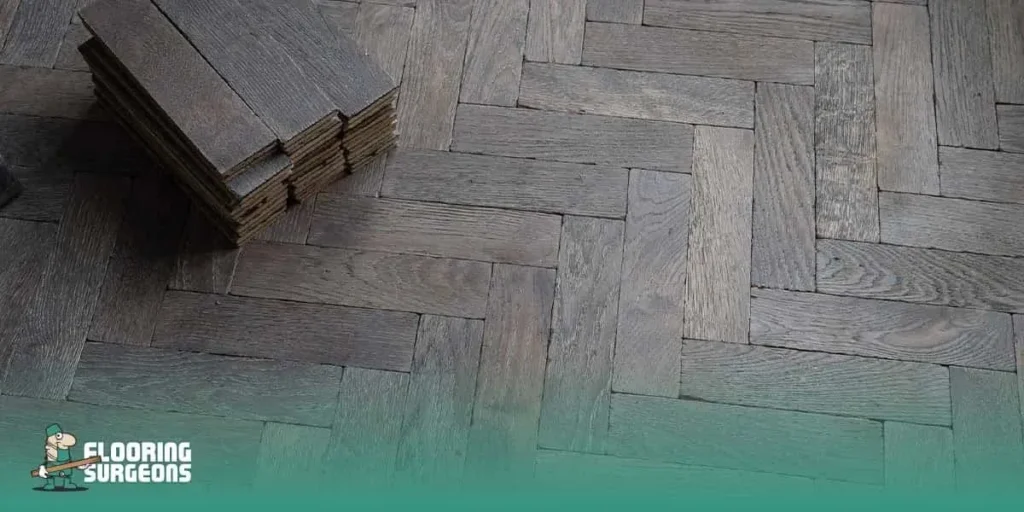
Recommended Tools
- Wood Spacers: These are essential for leaving the necessary expansion gap between the wood and the walls. It helps accommodate the natural expansion and contraction of the wood.
- Pull Bar: This tool is essential for pulling the last boards tightly into place, ensuring a snug fit without damaging the edges.
- Jigsaw: A jigsaw is perfect for cutting shapes or curves around fixtures, such as pipes or vents, ensuring a perfect fit even in tricky spaces.
- Combination Square: Use a combination square to make sure your cuts are at accurate right angles, ensuring precise alignment.
- Rubber Mallet: The mallet helps gently tap the boards into place without damaging the surface of the wood.
- Tapping Block: This tool helps ensure the boards are tightly locked together, especially in difficult spots where your hands can’t reach.
- Chisel: A chisel is helpful for any fine adjustments or trimming the edges of the floor planks.
- Drill: The drill is versatile for making pilot holes, which is especially useful when securing the wood with nails or screws.
- Beading or Skirting Boards: Beading or skirting boards are a great way to cover any gaps along the edges of the room, giving your floor a neat, finished look.
- Trowel: A trowel is used to apply the adhesive evenly when installing solid wood flooring on concrete.
- Safety Precautions: Ensure safety by wearing knee pads, safety goggles, dust masks, and ear defenders to protect yourself during installation. These will keep you safe from dust, loud noises, and the physical strain of bending and cutting.
For more professional advice or assistance, you can also rely on Flooring Surgeons, who specialize in solid wood flooring installation and can provide expert guidance throughout the process.
How to Choose the Right Type of Solid Wood Flooring for Your Space
Choosing the right type of solid wood flooring is essential for ensuring both aesthetics and durability. The first step is to consider the style of your room and the level of foot traffic. Oak, maple, and walnut are popular choices due to their strength and classic appearance. You should also think about the finish of the wood and how it complements your space. Whether you’re installing solid wood flooring on concrete or over a wood subfloor, ensure the wood is suitable for the environment and moisture levels of the area.
Once you’ve selected your flooring, it’s time to move on to the next important step: handling and storing your solid wood flooring properly before installation. Proper storage ensures that the wood acclimates to the environment, preventing any issues after installation.
How to Handle and Store Solid Wood Flooring Before Installation
Before you begin installing solid wood flooring, the proper handling and storage of the wood are crucial. To avoid warping or damage, lay solid wood flooring on concrete or a flat surface, and ensure the room temperature is stable. Wood planks should be left unopened and stored flat for at least 48 hours to allow for acclimatization. The ideal humidity level in the room should be between 45% and 65%. If you’re unsure about how to store solid wood flooring, remember to avoid stacking the planks too high or leaning them against the wall, as this can cause unnecessary pressure and lead to bowing.
Proper handling is especially important when installing solid wood flooring on concrete or over a wood subfloor. After acclimating the wood, you’re ready to begin the installation process, ensuring a smooth and lasting result.
How do I lay solid wood flooring on concrete?
The important tip to know how to install solid wood flooring on concrete correctly is to make sure it’s completely dry before installation. As concrete is porous, check moisture levels using a professional meter, acceptable moisture levels should be below 3% on a moisture meter or 12% on a prong test. Some meters use different scales, so always check the documentation. Installing a damp-proof membrane is essential to protect wooden boards from moisture.
How do I fit solid wood flooring on floorboards?
If the floorboards are clean, dry, and level, solid wood flooring can be laid directly on them. The best method for securing boards to timber subfloors is secret nailing at 90 degrees to the existing floorboards. If the floorboards are uneven, a 12 mm plywood subfloor should be installed. Avoid laying solid wood flooring directly onto chipboard, as chipboard lacks strength and moisture resistance.
To ensure the best results, regardless of the method you choose, using the right flooring underlay is essential. It will help with sound insulation, stability, and moisture protection, particularly if you’re installing solid wood flooring on concrete or over a wood subfloor.

Step-by-Step Guide to Laying Solid Wood Flooring
Now it’s time to get started with laying solid wood flooring. Lay the planks parallel to the longest wall or the main light source for a seamless look. Measure and cut the planks carefully, ensuring clean edges. The final row may need trimming to fit properly.
If you’re wondering, can you install solid wood flooring over concrete? The answer is yes! You can successfully install real wood flooring on concrete, but you’ll need to ensure proper subfloor preparation and moisture control.
Installing the Rows
- Glue-Down Method: Start from one corner and spread adhesive along the subfloor. Position the first row with the tongue facing away from the wall, using 10-12 mm spacers for an expansion gap. Ensure the row is perfectly straight, as this sets the direction for the entire floor. Apply adhesive 1 meter ahead of each row. This method is ideal when installing solid wood flooring on concrete, as it creates a strong bond between the wood and the subfloor.
- Nailing Method: Secure the first row with a nail gun. Then, use a powered flooring nailer or Tongue-tied screws to fix each plank through the tongue, ensuring hidden nails. Continue staggering the joints for a natural look. This method is typically used when installing over a wood subfloor.
- Floating Method: This method uses no nails or glue just click planks together over an underlay. Maintain a 10-12 mm expansion gap and stagger joints. It’s a flexible installation method, particularly for DIY enthusiasts, as it’s easier to manage and can be done without any adhesive or nails.
For all methods, place spacers consistently to maintain a uniform expansion gap from the sidewalls. Whether you’re installing over a concrete or wood subfloor, spacers are key to allowing the wood to expand and contract naturally.
Cutting and Fitting Around Obstacles
Use pre-cut boards for staggered joints. When fitting around pipes, position them at the center of a plank for easier cutting. Wood floor installation around obstacles such as pipes or vents requires precise cutting, so it’s important to plan ahead and ensure the cuts are neat and clean.
Finishing touch
The final row may need to be trimmed for a proper fit. Secure it tightly with a pull bar and rubber mallet. If necessary, surface nail the last row. For floating floors, ensure the last plank clicks securely into place.
For the glue-down method, leave the floor for 24 hours before using the space. To maintain a straight line, always check the alignment of the planks.
For solid wood flooring, a protective finish is important to preserve the wood. Common finishes include Polyurethane and Natural Oils.
The cost of finishing and maintaining your floor should also be factored in when considering how much it costs to install solid wood flooring. The overall cost can vary depending on the materials, method of installation, and finishing choices.
How do I maintain solid wood flooring?
After learning how to install solid wood flooring correctly, proper maintenance is key to keeping it in excellent condition. To prevent scratches, attach felt pads or castors to the bottom of chairs and tables. To maintain the superb natural look of the wood, avoid using abrasive cloths or excessive water when cleaning. Instead, opt for dry brushes, vacuum cleaners, or specialist wood flooring maintenance products designed to protect the finish and extend the lifespan of your floor.
Troubleshooting Common Installation Issues
When performing wood floor installation, it’s not uncommon to encounter a few issues. Below is a summary of common problems and their solutions to help you address them during the process of how to lay solid wood flooring.
| Issue | Cause | Solution |
| Uneven Subfloor | Subfloor is not level or smooth enough for installation. | Use a self-leveling compound or sand the subfloor. |
| Expansion Gaps Not Maintained | Spacers were not used, or gaps were ignored. | Always use spacers to maintain expansion gaps between boards. |
| Boards Not Lining Up Properly | Improper installation or lack of spacing. | Ensure proper alignment and stagger joints correctly. |
| Moisture Issues | Moisture from subfloor or environment. | Check moisture levels before installation. Use a vapor barrier if necessary. |
| Squeaky Floors | Nails or fasteners are loose, or improper subfloor prep. | Secure nails or fasteners properly, and check subfloor stability. |
These issues can arise when installing solid wood flooring, but with the right preparation and attention to detail, they are easily avoidable. If you’re wondering how to lay solid wood flooring on floorboards, ensuring that you stagger the joints and leave the correct expansion gaps is crucial for a successful installation.
Additionally, using the right Flooring Adhesive is essential when installing on concrete subfloors to prevent moisture issues and ensure a solid bond between the floor and the subfloor.
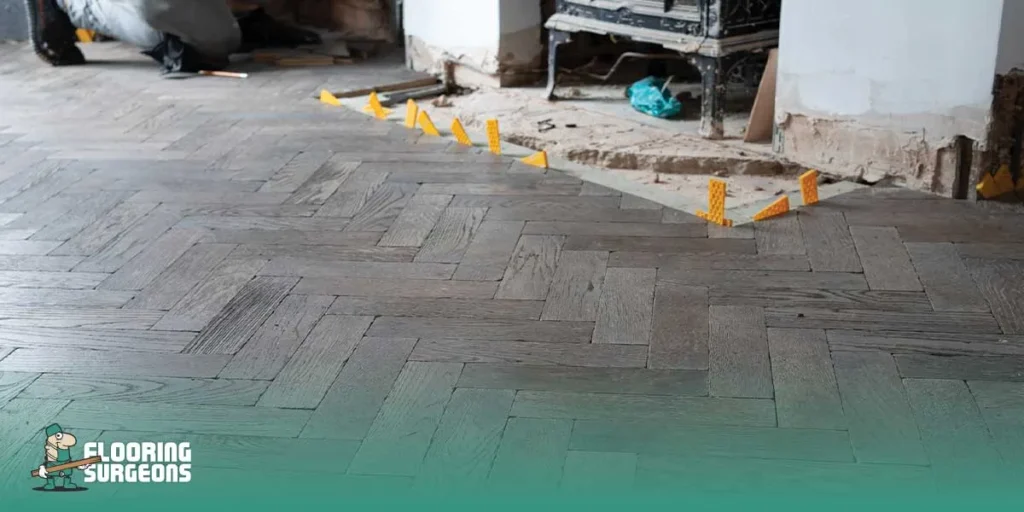
Common mistakes to avoid
If you’re not familiar with how to fit solid wood flooring, you may make some mistakes. Here are common mistakes you should be aware of:
Choosing the Wrong Type of Wood
Different types of wood have unique characteristics that impact durability and appearance. Ensure you select the right wood for your needs based on traffic levels and room conditions. For example, harder woods like oak are ideal for high-traffic areas, while softer woods like pine may show signs of wear more quickly. If you’re wondering how to install real wood flooring on concrete, remember that moisture-resistant woods work best for concrete subfloors to avoid damage from humidity.
Choosing the Wrong Finish
Choosing an unsuitable finish can lead to rapid wear and tear. For high-traffic areas, a durable finish, such as polyurethane, is recommended to protect your flooring from everyday damage. If you’re unsure about the finish for your solid wood flooring, consider the level of traffic and whether the room has exposure to moisture, as some finishes are better suited for kitchens or bathrooms.
Not Preparing the Subfloor
It’s crucial to check the moisture levels in your subfloor before installation to avoid future issues like shifting floorboards or cracks. A subfloor that is not level or has high moisture content can lead to long-term problems, especially if you are installing solid wood flooring on concrete. Always inspect the subfloor thoroughly and, if necessary, install a moisture barrier to protect your wood from future moisture damage.
Incorrect acclimation
Acclimating the wood helps prevent issues such as expansion or shrinkage, which could cause structural damage or warping of the floorboards. Ensure that the wood planks are allowed to adjust to the room’s temperature and humidity before installation. This step is crucial whether you’re installing solid wood flooring over wood subfloor or how to lay solid wood flooring on concrete, as wood naturally expands or contracts with environmental changes.
Insufficient Expansion Gaps and Improper Spacing
For correct installation, you must leave expansion gaps to allow for wood movement over time. Without proper spacing, your floor could buckle or loosen. Ensure a ¾ inch gap along walls for hardwood and ½ ½-inch gap for engineered wood. Additionally, the distance between nails or staples should be 10 to 12 inches, with at least two nails per floorboard, to prevent uneven movement.
This step is critical regardless of whether you’re laying wood as a subfloor or installing solid wood flooring over concrete.

Hire a Professional Flooring Contractor Today
The easiest way to avoid costly hardwood flooring mistakes is by hiring a professional flooring contractor. Skilled professionals use the right techniques to ensure your installation meets industry standards. Leave the installation of your flooring to the expert fitting and enjoy a flawless, long-lasting result!
Conclusion
Installing solid wood flooring can be a rewarding home improvement project, but it requires proper planning and attention to detail. From choosing the right wood and finish to preparing the subfloor and ensuring proper spacing, every step is crucial to achieving a beautiful, durable floor. If you’re unsure about how to install solid wood flooring or if the process feels overwhelming, consider hiring a professional to ensure a seamless installation. With the right expertise, your wood floor will enhance your home for years to come.



